6 tips for venturing beyond stainless steel in the kitchen
Because black, Tuscan, and saffron will blow your mind
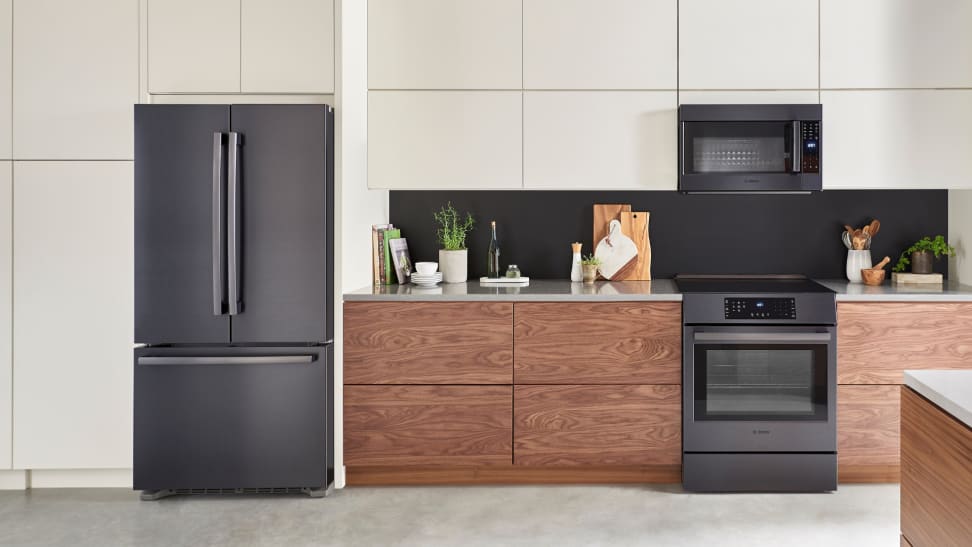 Credit:
Bosch Home Appliances
Credit:
Bosch Home Appliances
Products are chosen independently by our editors. Purchases made through our links may earn us a commission.
Since the 1970s, when harvest gold and avocado green were all the rage, kitchen appliance “fashion” trends have gone through several phases. There was the reactionary black and white in the 1980s, followed by a crush on stainless steel that began in the 1990s and continues today—with no end in sight.
While major appliance companies are banking on the continued popularity of this modern classic for the foreseeable future, over the last five years a wave of new finishes have started to hit the market, rivaling traditional stainless steel in their appeal.
If you’re in the market for a kitchen that stands out from the rest, these may be just the ticket. But, before taking the plunge, there are some things you should consider.
1. Beware of the quick hits
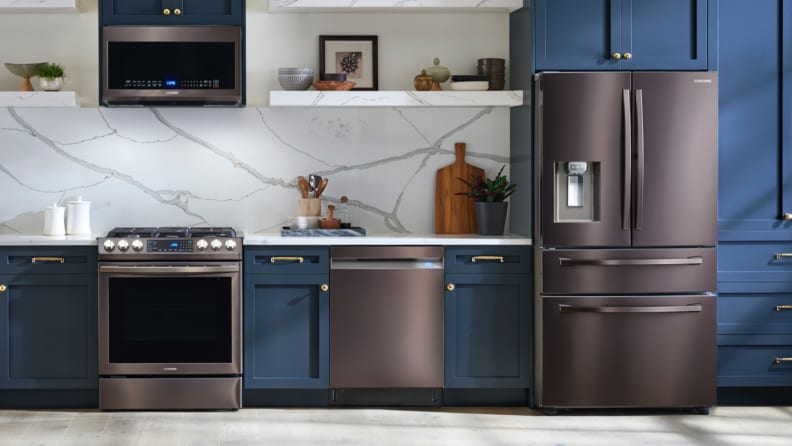
Avoid overly trendy stainless steel tones that may go out of fashion fast. An exception to this rule is Samsung's rich Tuscan Stainless.
Jay Ponte, store manager at Doyons Modern Home, in the Boston suburb of Bedford, Massachusetts, says, “Appliance companies have always been putting out feelers with different finishes.”
An appliance salesman and kitchen designer for over 20 years, Ponte cites JennAir’s Oiled Bronze and Whirlpool’s Sunset Bronze and White Ice as trends that have come and gone.
Steve Sheinkopf, CEO of Yale Appliance, says “Most of the ‘hot’ bronze finishes of yesteryear are discontinued.” Although an exception is Samsung’s Tuscan Stainless, introduced by the company in 2019 as “the new neutral.”
Jeff Allaire, marketing director with Bellingham Appliances in Bellingham, Massachusetts, describes Tuscan Stainless as a “somewhat bronzy, earth-toned metallic shade that should pair well with textured natural materials like marble slab and heavily grained wood.”
2. Consider black stainless as a solid alternative
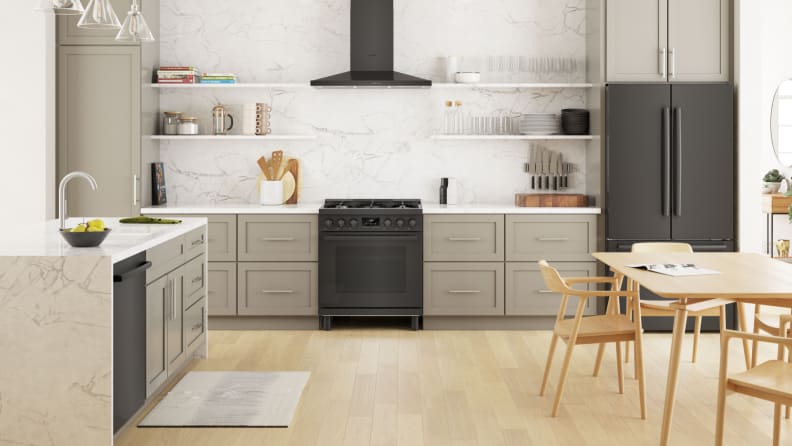
Unlike many other brands’ black stainless offerings, Bosch's version features more than just a coating of black oxide, which minimizes fingerprints and scratches.
Samsung—known as one of the most innovative appliance manufacturers—changed the look of the kitchen when it introduced black stainless steel into its line in late 2015. Doing so offered consumers a new stainless option with cool tones and a sleek, modern look. LG and KitchenAid introduced similar products around the same time, and since then just about all the major brands have jumped on the black stainless bandwagon.
Says Ponte, “Most companies have taken off with black stainless steel. People want something different, but not too much so.”
Bosch introduced its first black stainless steel kitchen suite in 2018, “to meet the growing demand for contemporary design in the kitchen,” explains Anja Prescher, director of brand marketing at Bosch home appliance.
Unlike many other brands’ black stainless, the groundbreaking product from Bosch features more than just a coating of black oxide.
“We took [the finish] to a new level utilizing a special material that helps guard against fingerprints and scratches,” explains Prescher. “We want consumers to trust that their appliances will stand the test of time.”
Ponte, along with Sheinkopf and Allaire, attest to the superiority of Bosch among black stainless steel contenders, saying it is the best brand to buy if you don’t want scratches on your black stainless to reveal the silver color of the stainless beneath it.
Black stainless steel is also less prone to fingerprints—the most common complaint consumers have about stainless appliances—than traditional stainless surfaces.
Manufacturers across the industry are responding with smudge-proof stainless surfaces. For example, KitchenAid offers a PrintShield finish for its recently launched FreeFlex Third Rack dishwasher.
3. Make sure you like the look enough to last a decade
Ranges, stoves and dishwashers should last an average of 10-12 years, so when selecting a finish, be sure you can live with it for at least that long.
Think about the possibility of having to replace one appliance in a suite. Many designer finishes, like the bronze tones mentioned above, were discontinued after their appeal diminished—very quickly, in some cases.
Black stainless seems like it will be around for a while, but color variations exist among different manufacturers, so it’s tricky to match across brands.
Allaire offers this example, “KitchenAid’s black stainless is a satin brushed black, while Samsung’s has a mirror finish and a graphite gray tone.” For a more tangible visual, just think about matching your black sweater with your black jeans, and you’ll get the picture!
Eloise Hale, head of corporate communications for Electrolux North America, says, “You can mix and match brands, but with a matching suite you get complementary design details such as matching trim, handles and lighting, which will pull your look together.”
4. Go eclectic—and own it
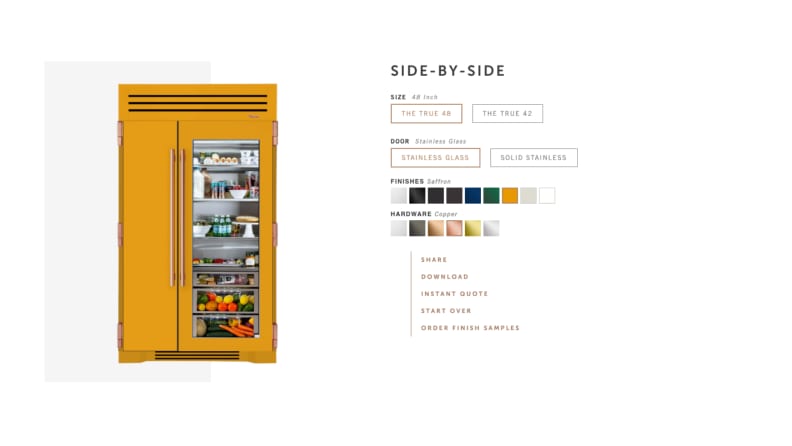
True Residential allows you to customize the finish and hardware of your stainless steel fridge. Saffron with copper is pictured. Cobalt blue is one of the most popular choices.
If your style leans more toward eclectic than matching, and you’re looking for a pop of color, you may want to consider a refrigerator from True Residential, a special brand that has a huge repertoire of powder-coated custom finishes over its stainless steel units, including emerald green and, the latest, saffron.
Steve Proctor, True Residential director of sales and marketing, says blue is a current favorite. “The demand for our cobalt hue is more than double any of the non-neutral colors. This illustrates that calming tones like blue are being sought after during these uncertain times, and this is something that is on trend with what we are hearing from designers.”
5. Consider versatility rather than tradition
Whitney Welch, a senior brand communications specialist with GE Appliances, recommends considering the overall tone of your home. “[Appliances with different finishes] also became popular as people were designing more open-concept homes and wanted their kitchens to better match other areas of their homes,” she says.
Although traditional stainless steel is often pegged as industrial-looking, in reality it fits in with a wide range of looks besides modern. You can also think about mixing metal finishes in your home.
Ponte says, “Stainless steel is like blue jeans, it works with everything.”
If you’re dead set against traditional stainless steel, black stainless steel is also very versatile.
Hale explains, “It offers consumers a modern alternative to the already beloved stainless finish, and it works with almost all cabinet styles and colors.”
Wendy Savino, kitchen designer at Metropolitan Kitchens in Watertown, Massachusetts, says, “Everything was neutral for a long time. Then grays followed, which were a softer neutral that was neither white nor a strong color commitment. The stainless worked with both of those really well. Gray in home décor is still fairly popular, but the other color that seems to be coming back strong is black.”
Savino acknowledges—and other interior designers concur—that there is a trend toward introducing wood finishes back into the kitchen to warm things up a little bit. The use of wood, both rustic and finished, often spills over into the rest of the home. Stainless, black stainless and Tuscan finishes all complement the look, which is characterized by natural textures like the wood grains and thick-veined marble, along with warmer paint colors.
6. Maybe matte is an option
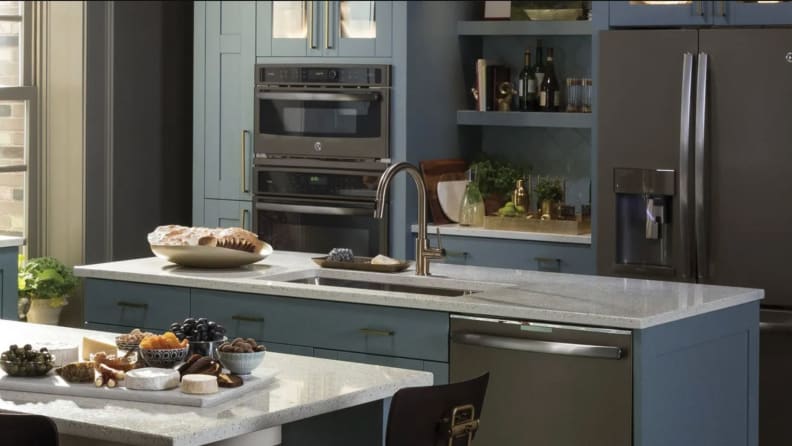
GE's signature matte finish, Slate, has a metallic look but one that is warmer than stainless steel.
While it’s not stainless, slate-colored matte finishes are popular with consumers, as well. GE introduced Slate, a warm gray, low-gloss metallic finish designed as a premium alternative to stainless steel back in 2012, even before black stainless steel.
Allaire shares, “Slate maintains a metallic look but with a matte finish that is not as stark and cold as stainless steel and also warmer than black stainless steel.”
Kristin Payton, showroom manager at White Wood Kitchen in Sandwich and Kingston, Massachusetts, agrees. She even chose GE Slate appliances for her own home.
“My kitchen is very small, and I thought stainless steel would overpower it,” she says. “It just felt a little warmer to me [than stainless steel], and it’s very versatile. It goes beautifully with any painted cabinets.”
Without even mentioning all the new custom colors popping up in appliances—Bluestar offers more than 750—the options for consumers looking to update their kitchens are dizzying.
As Payton says, “If you haven’t been to an appliance store lately, it will blow your mind.”


